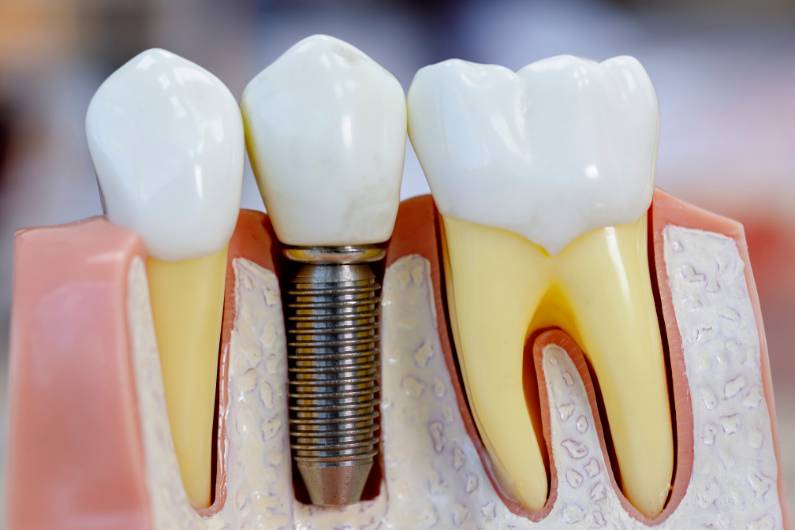A typical dental implant consists of a dental post and a crown on top. But depending on your exact situation, there are different types of dental implants that can prove to be a better, cheaper, and more efficient option for you. Before you set out on getting one or multiple dental implants, take a moment to see what types are available, which one may be best for your needs, and where to go in Fontana for high-quality dental implants with the best care in the area.
Endosteal Implants
Being the most common type of dental implant, endosteal implants are placed directly into the jawbone during a surgical procedure. It consists of the typical structure that you would imagine when you first think of a dental implant. You have a titanium screw to use as the post of the implant which acts as the new “root” of your replacement tooth. It will take some time for the bone to heal and form around this new post, but once that period of healing is complete, your dentist will complete the procedure with a dental crown. Porcelain crowns (or porcelain infused with metal) are usually preferred because the composition looks similar to a natural tooth while being as durable as one, too.
|
Why Use Titanium Screws? A top-rated dentist will prefer to use titanium screws to use for the dental implant post as opposed to ceramic because metal is stronger and more durable for long-lasting results. And since you can’t see the post under the crown, it doesn’t matter what it looks like anyway! |
Subperiosteal Implants
Not everyone has the makeup to support an endosteal implant. If the patient’s jawbone doesn’t have the right height or density for an endosteal implant, then a subperiosteal implant is the next best choice. These types of implants can be placed on top of the jawbone, or just underneath the gum tissue. Although not as durable as endosteal, subperiosteal implants still have a metal framework for supporting fake teeth and even a dental bridge depending on the needs of the patient.
Full-Arch Implants
Also referred to as an all-on-4 implant, a full-arch implant is a go-to for patients who have lost an entire row of teeth. Whether the entire upper row, bottom row, or both rows of teeth are missing, a full-arch implant can still provide a stable set of teeth that look and feel natural. This is accomplished by using four implants to hold the arch in place, two implants on either side. This is often thought of as a permanent set of dentures that you won’t have to remove, clean, and replace every day.
The Benefits of Full-Arch Implants Over Dentures
| Full-Arch Implants | Dentures |
|
|
Mini Implants
As the name suggests, mini implants are a smaller version of your typical dental implant. This size is sometimes needed in situations where there is not enough bone volume to support other procedures. For example, you may need a mini implant to use as a stabilizer for a denture. Mini implants are less invasive than other types of implants as all you need is a small incision. You might even be able to avoid the need for any bone grafting given the situation. Other reasons that call for a mini implant include:
- Having limited space in the mouth so there’s no room for a full-sized implant.
- Not having the bone density to keep a full-sized implant stabilized.
- The need for less-intrusive procedures for better healing, reduced discomfort, and shorter recovery times.
- Having a shorter time frame in which a faster recovery time is needed.
Finding The Right Implant For Me
To simplify the uses for each type of implant and which one is right for you, you much first consider your exact situation and your goal in seeking treatment. What does your mouth look like right now, and what do you hope for in terms of end results?
For Single Tooth Replacements: Endosteal
When you simply need to replace a tooth or even a couple of teeth, endosteal is the way to go. This is primarily why it’s the most popular type of dental implant, mostly because many situations only call for a single tooth replacement.
For Replacing An Entire Row: Full-Arch
Most people will resort to removable dentures once they lose an entire arch of teeth, and that’s not necessarily a bad thing. To many people, it’s an easy and affordable option. But for people who want to continue enjoying the stable natural-tooth experience even after losing so many teeth, full-arch implants are the closest that you can get.
For Tight Spaces Or Supporting Dentures: Mini Implants
Mini implants aren’t usually people’s first choice. In fact, many don’t even realize that they exist until they need one. But when there’s not enough space for a full-sized implant or if you just need a bit of leverage in supporting a denture, mini implants are very useful in those aspects.
For Smaller And Weaker Jawbones: Subperiosteal
Subperiosteal implants are a great alternative for patients who don’t have the jawbone density to reliably support an endosteal implant. But as long as you see a skilled dentist, a subperiosteal implant can still give you a quality restorative treatment.
Getting The Best Dental Implants In Fontana
No matter what kind of dental implant you need, Southridge Dental Group can equip you with a high-quality tooth replacement with skilled restorative dental care. Call 909-822-9090 to learn more about the different types of dental implants that are offered and to schedule a consultation!

